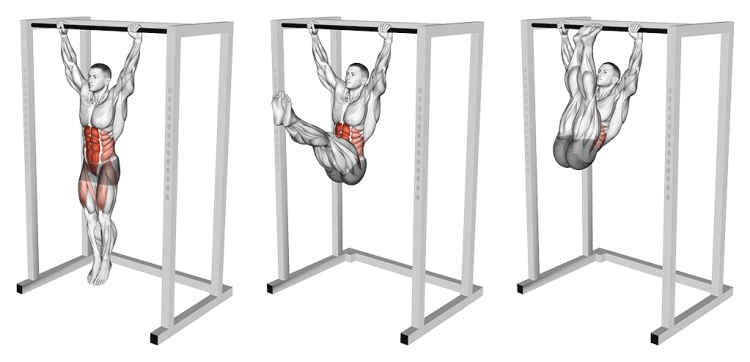Toes-to-bar is primarily a core exercise that entered the mainstream after it became a staple in CrossFit workouts. Nonetheless, most CrossFitters let out a long sigh of despair on seeing this exercise as a part of their WOD (workout of the day). This demanding exercise has featured in almost every recent CrossFit Games finals.
The toes-to-bar is an advanced variation of the leg raise. As the name implies, it involves touching your toes to the bar while hanging onto a pull-up bar. This gymnastics exercise requires a decent amount of core, shoulder, arms, grip, back, and lower body strength and excellent mobility. You’ll have a hard time completing a strict toes-to-bar rep if you lack in even one of these areas.
The toes-to-bar is a compound exercise that engages multiple joints and muscle groups. Furthermore, you need good hand-eye coordination to perform this exercise, especially if you’ll be performing a high number of repetitions.
You need a lot of practice and skill to perform the toes-to-bar like an elite CrossFit athlete. Although you could get better at this exercise by practicing it in each workout, adding toes-to-bar alternatives to your training regimen can be an incredibly effective way of strengthening your primary and supporting muscle groups, boosting your mobility, nailing down your form, and making your workouts more interesting.
In this article, we have put together the nine best toes-to-bar alternatives. You could use these exercises to replace the TTB and add variety to your WODs or use them as progression movements for a stronger toes-to-bar.
How To Perform the Toes-To-Bar
Before we get into the TTB alternatives, let’s look at how to perform this exercise with the correct form. There are three common toe-to-bar alternatives — kipping, scooping, and strict. You can choose the one you’re the most comfortable with, depending on your mobility and upper body strength. We, however, recommend alternating between the three methods to ensure you’re not leaving any weak spots.
Level Up Your Fitness: Join our 💪 strong community in Fitness Volt Newsletter. Get daily inspiration, expert-backed workouts, nutrition tips, the latest in strength sports, and the support you need to reach your goals. Subscribe for free!
For the scope of this article, we’ll talk about kipping TTB as it is the most common variation of the exercise.
Steps:
- Grab a pull-up bar with a slightly wider-than-shoulder wide overhand grip.
- Your body should be in a straight line from hands to toes at the starting position.
- Begin the kipping motion by switching between the arch and hollow positions.
- Raise your knees to your chest as you get into the hollow position.
- Push down on the bar with straight arms, simultaneously extending your knees so your toes touch the bar at the top of the movement.
- Lower your legs to the starting position.
- Repeat for recommended reps.
Pro Tip: Avoid using a false (thumbless) grip while doing this exercise, as it can hamper your forearm engagement. You can hold onto the bar for longer with a full grip — thumbs wrapped around your fingers.
Benefits of Toes-To-Bar:
- TTB helps build a diamond core.
- Performing the TTB helps improve your mobility.
- A functional exercise that works your core, shoulder, arms, back, and lower body.
- Improves grip strength.
- Boosts muscle endurance and stamina.
9 Best Toes-To-Bar Alternatives
Use the following TTB alternatives and variations to build a stronger core:
- Hanging Leg Raise
- Hanging Knees-to-Chest
- Captain’s Chair Leg Raise
- Hollow Body Crunch
- V-Ups
- Toes-to-Kettlebell
- Ab Wheel
- L-Sit
- Lying Leg Raise
Hanging Leg Raise
The hanging leg raise is the most-obvious and easier variation of the toes-to-bar. It cuts down the TTB range of motion in half, making it a more suitable exercise for beginners. Perform the hanging leg raise using the three variations (kipping, scooping, and strict) to get a better grip on these movements.
Steps:
- Grab onto a pull-up bar with a shoulder-wide overhand grip.
- Your body should be in a straight line from hands to feet at the start position.
- Contract your core and glutes, and raise your legs as high as possible toward the ceiling.
- Your legs should at least break parallel with the floor.
- Pause and contract your abs at the top.
- Slowly return to the starting position.
- Repeat for reps.
Pro Tip: As you get better at this exercise, use additional resistance by wearing ankle weights. Also, make sure your arms are straight while performing this exercise.
Benefits of Hanging Leg Raise:
- It helps build a stronger core.
- It works the more stubborn lower abs.
- The hanging leg raise is one of the best progression exercises for the toes-to-bar.
Check out our complete hanging leg raise guide here!
Hanging Knees-to-Chest
This exercise is a hanging leg raise variation and involves bringing your knees to your chest. Folks with a limited hip flexor, glute, and hamstring mobility should start with this exercise.
Beginners can make this exercise easier by limiting their range of motion. Instead of touching your quads to your chest, lift your legs until your quads are parallel to the floor.
Steps:
- Grab an overhead bar with a shoulder-wide pronated grip.
- Contract your glutes and core, and lift your quads to your chest by bending your knees. Avoid using momentum.
- Pause at the top of the movement.
- Slowly return to the start position and repeat for reps.
Pro Tip: After you can complete the hanging knee-to-chest with the perfect form, you should move toward the hanging knees-to-elbows. This variation will require greater core strength and is a progression to the TTB.
Benefits of Hanging Knees-to-Chest:
- An excellent exercise for beginners.
- The hanging knee-to-chest exercise can improve hip flexor, glute, and hamstring mobility.
Captain’s Chair Leg Raise
The captain’s chair leg raise is arguably the best leg raise exercise for beginners who want to work toward the toes-to-bar. For most folks, their grip strength is the limiting factor while performing the TTB, hanging leg raise, or hanging knees to chest.
However, the captain’s chair removes your grip strength from the equation as you’ll be resting your arms on the chair’s arms.
Steps:
- Place both feet on the equipment’s foot platform.
- Position your back against the back pad, grab onto the handles, and plant your forearms on the arm supports.
- Take your feet off the platform.
- Your body should be in a straight line from head to heels at the start position.
- Contract your core and glutes, and raise your legs as high as possible toward the ceiling.
- Keep your knees locked throughout the exercise.
- Pause at the top.
- Slowly return to the start position and repeat for recommended reps.
Pro Tip: Beginners can start by performing the knees-to-chest until they develop the core strength to complete a conventional captain’s chair leg raise. Ensure you don’t use momentum by swinging your legs behind your body while performing this exercise, as it can put unnecessary stress on your spine.
Benefits of Captain’s Chair Leg Raise:
- This exercise is excellent for beginners who lack the grip strength to go unbroken on the recommended leg raise reps.
- It helps you better focus on your abdominals as it eliminates lat and arm engagement.
Check out our complete captain’s chair leg raise guide here!
Hollow Body Crunch
The hollow body crunch is a great exercise to work toward a stronger TTB. Not only does this exercise help build a stronger core, but it also aids in improving your hollow body hold position, which can be vital to success at the TTB.
Steps:
- Lie face-up on the floor.
- Drive your lower back into the floor by contracting your abs and bracing your core.
- Get into the hollow body position by lifting your legs, arms, head, and shoulders off the floor. Your arms should be extended over your head.
- Bring your quads to your chest by bending at your knees while performing a sit-up and bringing your elbows close to your upper legs.
- Rinse and repeat.
Pro Tip: Perform this exercise with a slow and controlled range of motion for optimal core engagement. Rushing through the reps and using momentum by driving through your arms can strain your lower back.
Benefits of Hollow Body Crunch:
- The hollow body crunch is one of the best no-equipment TTB alternatives.
- It improves your hand-eye coordination.
Check out our complete hollow hold crunch guide here!
V-Ups
The V-up is a slight variation of the hollow body crunch. However, both these exercises train your abs uniquely. The V-up takes your abs through a more extensive range of motion, resulting in greater abdominal and core stimulation.
Steps:
- Lie on your back on the floor.
- Extend your arms overhead. Your body should be in a straight line from hands to heels in this position.
- Lift your heels, hands, and head a few inches off the floor. This will be your starting position.
- Lift your legs as high as possible toward the ceiling by contracting your glutes and core, simultaneously perform a crunch and bring your hands close to your feet.
- Your body should form a “V” at the top of the position.
- Slowly return to the start position. Ensure your heels, hands, and head don’t touch the floor.
- Repeat for reps.
Pro Tip: Beginners who lack core strength can place their heels, hands, and head on the floor with each rep. Use a slow and controlled motion to perform the crunches. Plus, keep your legs as straight as possible.
Level Up Your Fitness: Join our 💪 strong community in Fitness Volt Newsletter. Get daily inspiration, expert-backed workouts, nutrition tips, the latest in strength sports, and the support you need to reach your goals. Subscribe for free!
Benefits of V-Ups:
- It keeps constant tension on your abs throughout the range of motion.
- Since this exercise requires no equipment, you can do it anywhere.
Check out our complete V-ups guide here!
Toes-to-Kettlebell
The toes-to-kettlebell is one of the best floor exercises to work toward the TTB. It mimics the strict toes-to-bar variation and can help improve your core strength and mobility.
Steps:
- Place a kettlebell on the floor.
- Lie supine on the floor, extend your arms overhead, and grab the kettlebell’s handle with both hands.
- Drive your lower back into the floor, contract your glute and core, and lift your legs toward the ceiling. From there, lift your lower back off the floor and lower your toes to the kettlebell’s handle.
- Slowly return to the starting position.
- Rinse and repeat.
Pro Tip: Beginners should begin with a scaled variation of the toes-to-kettlebell. Begin by lifting your legs toward the ceiling until they are perpendicular to the floor. Increase your range of motion as your mobility improves.
Benefits of Toes-to-Kettlebell:
- The toes-to-kettlebell floor exercise improves your core strength and mobility.
- Holding onto the kettlebell ensures you don’t lift your arms to meet your feet midway.
Ab Wheel
Using an ab wheel delivers optimal abdominal muscle extension. It will also engage your arms, back, glutes, hamstrings, and shoulders, which play a crucial role in the toes-to-bar. If you don’t have access to an ab wheel, you can use a barbell for this exercise.
Steps:
- Kneel on the floor while holding onto an ab wheel with both hands.
- Place the ab wheel on the floor in front of your knees.
- Slowly roll the ab wheel away from your body while bracing your core.
- Your arms should be extended overhead and your chest a few inches from the floor at the movement’s bottom.
- Return to the starting position.
- Repeat for reps.
Pro Tip: Advanced exercises can perform the standing ab wheel rollout for a nasty ab pump. You need a strong core and decent mobility to perform this ab wheel rollout variation.
Benefits of Ab Wheel:
- While most ab exercises focus on ab contraction, the ab wheel rollout focuses on ab extension.
- This exercise recruits the same muscle groups engaged in the toes-to-bar.
Check out our complete ab wheel guide here!
L-Sit
The L-sit is one of those exercises that look super easy but requires decent skills and practice to perform correctly. Beginners should use parallel bars to perform the L-sit, as doing it on the floor requires much more core strength and mobility.
Steps:
- Adjust the parallel bars so the handles are under your shoulders.
- Grab the bars with a neutral (palms facing inward) grip.
- Lock out your elbows and push your shoulder back and down.
- Contract your core and glutes and lift your legs toward the ceiling.
- Your legs should be straight and break parallel with the floor at the top.
- Pause for the recommended time.
Pro Tip: Perform the L-sits on the captain’s chair if you have difficulty performing them on parallel bars. You can then progress to hanging L-sits before moving on to the parallel bar L-sits. As we said, this exercise looks easy but requires a lot of practice.
Benefits of L-Sit:
- The L-sit improves your core strength and stability.
- This exercise will add stability and control to the toes-to-bar.
Lying Leg Raise
Newbie exercisers should start their ab training journey with the lying leg raise. It will help build a stronger core and a shredded midriff and also aid in developing the hip flexion required to complete a TTB.
Steps:
- Lie supine on the floor.
- Place your hands under your hips for support.
- While maintaining a slight bend in your knees, lift your legs toward the ceiling until they are perpendicular to the floor.
- Slowly lower your legs toward the floor until your heels are a few inches away.
- Repeat for recommended reps.
Pro Tip: You could also perform this exercise on an elevated platform like a flat bench. It allows a better ab extension at the bottom of the movement, leading to greater abdominal muscle stimulation.
Benefits of Lying Leg Raise:
- The lying leg raise improves hip flexion and core strength, which can translate to a better TTB performance.
- The lying leg raise is a beginner-friendly exercise that works the stubborn lower abs.
Check out our complete lying leg raise guide here!
Muscles To Focus on For Boosting Toes-To-Bar Performance
The toes-to-bar is a functional exercise, meaning it engages multiple muscle groups. Although TTB can help build bigger and stronger muscles, going into the exercise with lagging muscles can hamper your performance. You must work on the following muscle groups with accessory lifts to finish strong on this exercise:

Core
Your core is the primary target muscle group of the TTB. You need decent core strength to lift your feet to an overhead bar. Limiting your core training to crunches and sit-ups won’t cut it if your goal is to perform a strict TTB.
Add exercises like hollow holds, Supermans, and V-ups to your training regimen, as they can help build a stronger core. Not to mention, performing the toes-to-bar with the correct form will help you build a titanium core. All the TTB alternatives and variations listed in this article will help you achieve a strong core.
Grip Strength
While performing the TTB, you are as strong as your grip strength. It doesn’t matter how strong your core, shoulders, back, or biceps are; if you have poor grip strength, you’ll have no other option but to watch other folks in your box lap you on the toes-to-bar.
Functional exercises like the deadlift, farmer’s carry, and bent-over rows are potent ways to improve your grip strength. Furthermore, you should limit the use of lifting straps to build a stronger grip.
Hip Flexors
The role of hip flexors is often overlooked while performing the toes-to-bar. Hip flexors are located along the front of your upper thigh and are responsible for flexing the hip and bringing the leg upward toward the chest.
Additionally, you must work on your hamstring and glute mobility to improve your TTB performance. Tight hip flexors, hamstrings, and glutes will limit your range of motion, and you’ll have to use a lot more of your core to lift your feet to the bar.
Shoulders and Back
You need a decent shoulder and back mobility to complete the TTB. Folks that lack overhead and shoulder mobility cannot hold the overhead bar as long as people with good upper body flexibility, which hampers their performance on the exercise.
Furthermore, good shoulder and back flexibility will allow you to get into the hollow and arched kipping positions more effectively. It will ensure that your turn-around time between reps is fairly low.
Wrapping Up
The toes-to-bar is a staple in most CrossFit workouts. This functional exercise engages your core, back, shoulders, arms, and lower body.
Beginners can have difficulty completing the TTB with the correct form. This article lists nine exercises you can use as alternatives to the TTB. Plus, these exercises double as progression movements that will help you move toward your first strict toes-to-bar rep. Getting your first TTB might require a lot of patience, hard work, and dedication. So, put your head down and get to work. It will all be worth it. Best of luck!
Interested in measuring your progress? Check out our strength standards for Sit Ups, Deadlift, Superman, and more.








